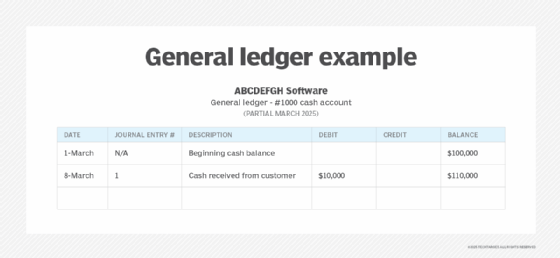What is a general ledger (GL)?
A general ledger (GL) is a set of numbered accounts a business uses to keep track of its financial transactions and to prepare financial reports. Each account is a unique record summarizing a specific type of asset, liability, equity, revenue or expense. A chart of accounts lists all of the accounts in the general ledger. A large business can have thousands of accounts in its GL.
Certified public accountants (CPAs) and bookkeepers typically access and use general ledgers. Following the accounting equation, any debit added to a GL account has a corresponding and equal credit entry in another account and vice versa.
Companies use general ledgers to do the following:
- Monitor finances.
- Track transactions and cash flow.
- Compile and maintain information for business-related reports.
- Ensure tax compliance.
- Help prevent accounting errors and fraud.
Why do companies use general ledger accounts?
A general ledger offers value to businesses in several ways, including the following:
- Generates financial statements. GLs generate several important financial statements for various internal stakeholders. They can use the financial information provided in those statements when making business decisions.
- Provides accounting records. A GL also provides financial accounting records for an organization's business transactions and account balances. These records and financial data can help accountants spot unusual, erroneous or fraudulent transactions.
- Optimizes cash flow management. GLs can generate cash flow statements to facilitate cash flow management.
- Facilitates auditability. Organized transactional records help simplify audits and bolster compliance.
- Helps create a trial balance. A GL enables a business to compile a trial balance where all debits and credits are totaled. Most organizations do this periodically, often at the end of a reporting period, to proactively stay on top of expenses.
How does a general ledger work?
The general ledger functions as a collective summary of transactions posted to subsidiary ledger accounts, such as cash, accounts payable, accounts receivable and inventory.
General ledgers work using a double-entry accounting method. This approach shows expenses and income items in dollar amounts as debits and credits. Each general ledger item or entry can be divided into the following four main parts:
- A journal entry describing the item number of the transaction posted to the account.
- A description of the specific transaction.
- A debit or credit value for the net balance change.
- A resulting balance after the credit or debit is posted.
During the bookkeeping process, other records outside the general ledger, called journals or daybooks, are used to record transactions daily. The general journal consists of the accounting entries for each business transaction arranged by date.
These transactions can include cash payments against an invoice and their totals, which are posted in corresponding accounts in the general ledger. Accounting software typically records the transactions in sub-ledgers or modules.
The totals calculated in the general ledger are then entered into other key financial reports, notably the balance sheet -- sometimes called the statement of financial position. The balance sheet records assets and liabilities; the income statement shows revenue and expenses.
Income statements are considered temporary accounts closed at the end of the accounting year. Their net balances -- positive or negative -- are added to the equity portion of the balance sheet. For example, the equity portion might include the shareholders' or owners' equity in a private company, retained earnings in a nonprofit organization, and figures derived by subtracting liabilities from tangible and intangible assets. In contrast, the accounts that feed into the balance sheet are permanent accounts used to track the business's ongoing financial health.
General ledger accounts aren't budget accounts. Instead, they show actual amounts spent or received and not merely projected in a budget.
A company might use blockchain technology to store its general ledger, which can prevent fraudulent accounting transactions and preserve the ledger's data integrity. However, blockchain's heavy processing infrastructure requirements must be taken into account when considering such a move.
Types of general ledger accounts
Broadly, the general ledger contains accounts corresponding to the income statement and balance sheet for which they are destined.
The income statement might include totals from general ledger accounts for cash, inventory and accounts receivable, which is money owed to the business. These accounts are sometimes broken down into departments, such as sales and service and related expenses. The expense side of the income statement might be based on GL accounts for interest and advertising expenses.
Other GL accounts summarize transactions for asset categories, such as physical plants and equipment, and liabilities, such as accounts payable, notes or loans.
Other types of GL accounts
While the above accounts appear in every general ledger, other accounts can be used to track special categories, perform useful calculations and summarize groups of accounts. The latter type is called a control account.
For example, a CPA might use a T-account -- named because of its physical layout in the shape of a T -- to track only the debits and credits in a particular general ledger account. Equity accounts are another category of GL accounts. They track a company's value and include stockholders' equity, common stock and retained earnings.
General ledgers and double-entry bookkeeping
Following the rules of double-entry bookkeeping, each entry in the general ledger must appear in two places: once as a debit and once as a corresponding credit. And the two added together must equal zero.
In accounting, the terms debit and credit differ from their commonplace meanings. Whether each adds to or subtracts from an account's total depends on the type of account. For example, debiting an income account causes it to increase, while the same action on an expense account results in a decrease. Goods-receipt/invoice-receipt accounts can have either a credit or debit balance.
General ledger reconciliation
At the end of each fiscal period, a trial balance is calculated by listing all the debit and credit accounts and their totals. Those with debit balances are separated from the ones with credit balances. The debit and credit accounts are then totaled to verify that the two are equal. If they aren't, the accountant looks for errors in the accounts and journals.
However, the trial balance doesn't serve as proof that the other records are free of errors. For example, if journal entries for a debit and its corresponding credit were never recorded, the totals in the trial balance would still match and not suggest an error.
Companies use a general ledger reconciliation process to find and correct such errors in accounting records. In some areas of accounting and finance, blockchain technology is used to make the reconciliation process faster and cheaper.
General ledger accounting software
For centuries, general ledgers were kept on paper. However, in recent decades, they've been automated using enterprise accounting software and in enterprise resource planning applications. These tools integrate core accounting functions with modules for managing related business processes.
Some of the business processes managed by GL include the following:
- Order management.
- Human resource management.
- Enterprise asset management.
- Inventory management.
- Risk management and compliance.
- Supply chain management.
- Customer relationship management.
- Business intelligence and forecasting.
- Financial reporting.
In such systems, the GL serves as a central repository for the accounting data.
General ledger software should include the following features:
- Bank reconciliation.
- Financial reporting.
- Accounts receivable and payable.
- Cash flow statements.
- Tax preparation.
- Workflow automation.
- Customizations.
- Integrations with other systems, including customer resource management, payroll and e-commerce.
- Reporting and analytics.
- Mobile applications.
- Audit and compliance.
General ledger transaction example
The following example shows an accounting system transaction within a general ledger for a fictional account, ABCDEFGH Software. Note that this example refers to ABCDEFGH Software's cash account.

The leftmost column in the example above is the date of the transaction. To its right is the journal entry number associated with the transaction, which contains an identifying number associated with the transaction.
The description of the transaction states the reason behind the transaction. In this example, the transaction is for a cash payment from a client account to ABCDEFGH Software. Since the cash account is receiving income, the debit column shows an increase and displays a sum of $10,000.
The credit column for this transaction remains unchanged. However, a separate ledger for the company's accounts receivable will reflect a credit reduction for the same amount because ABCDEFGH Software no longer has that amount receivable from its client.
To maintain the accounting equation's net-zero difference, one asset account must increase while another decreases by the same amount. After the net change from the transaction, the new cash account balance will be reflected in the balance category.
A general ledger is an important, fundamental accounting tool. GLs and accounting can be improved using blockchain technology. Learn how other industries are using blockchain technology.






